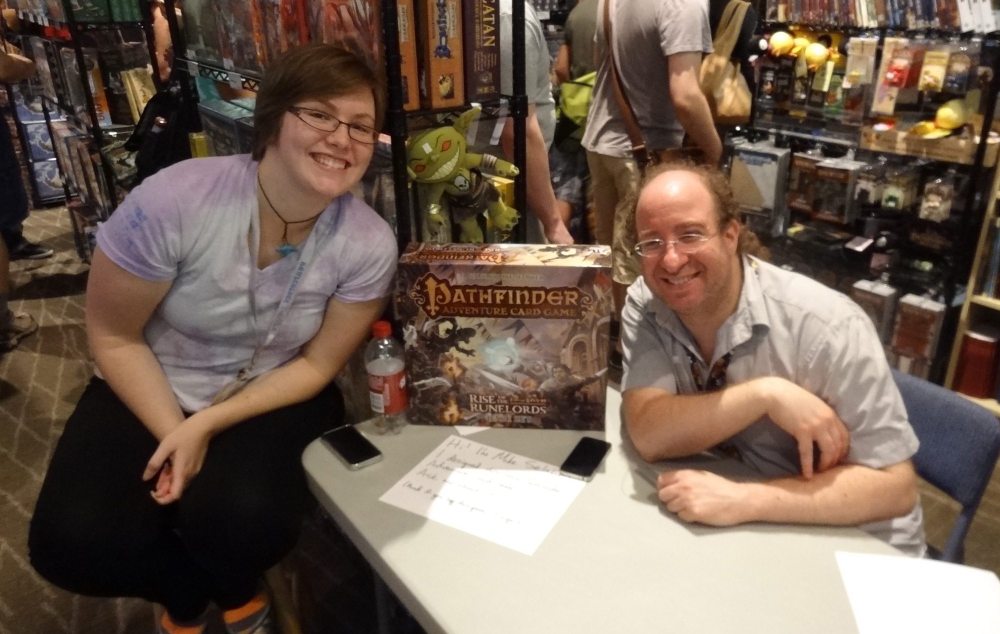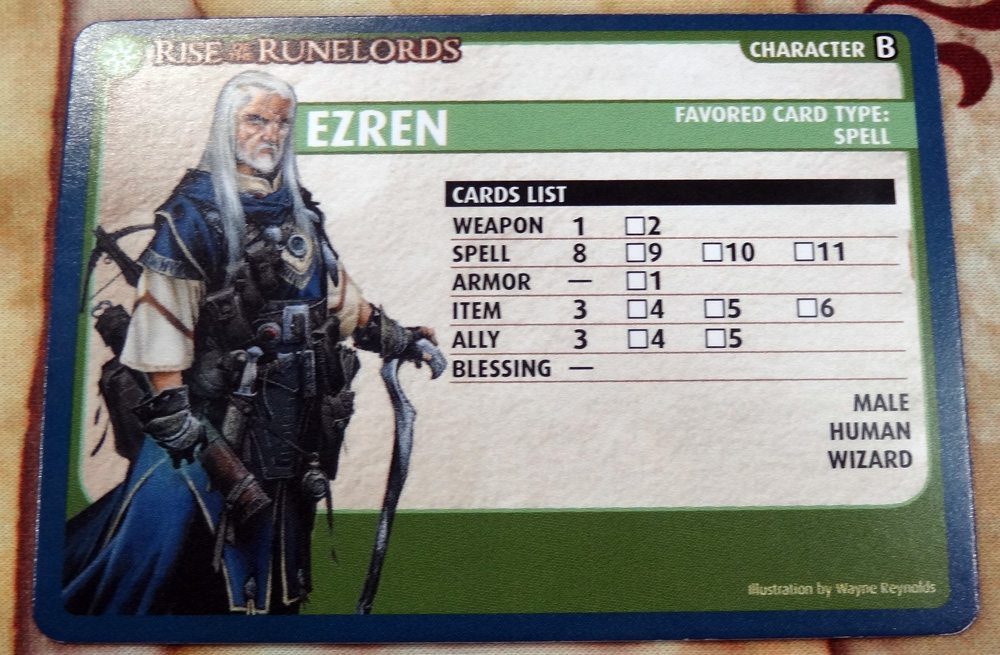
One of the hits of Gen Con this year was the Pathfinder Adventure Card Game from Paizo Publishing, which sold out on the first day of the show. The Paizo booth was filled throughout the weekend with people trying out the demo. It’s a card game set in the Pathfinder world that takes players through a series of scenarios to form a campaign; your character will level up as you play (assuming you succeed, of course). I got a chance to ask a few questions of the game designer, Mike Selinker of Lone Shark Games.
GeekDad: I’m a newbie when it comes to Pathfinder, but I love card games and I’m particularly fond of trying out new ways to use the deck-building mechanic. I was delighted to see that the game you let me playtest at Gamestorm 2012 had become the Pathfinder Adventure Card Game. [Note to readers: although deck-building was more prominent in the original prototype, the Pathfinder ACG isn’t really a deck-builder in the usual sense.] Could you start by sharing a little bit of your inspiration for the mechanics of the game? Did you start with a world and mythos, or did you start with some game mechanics in search of a story?
Selinker: I can’t get too deep into the nature of that prototype game, because I hope to produce it later down the line. But you’re definitely right that it was the inspiration for the Pathfinder ACG. I started with an idea from my business partner, Rian Sand, about a setting and a way to think about card games and RPGs. I crafted the game in concert with the world, which author [and GeekDad contributor] Matt Forbeck helped us develop. But at the time I wasn’t too concerned about the details. We needed to know whether the system worked, and it didn’t make sense to just play a storytelling game without a story. When we moved over to Pathfinder—we always imagined that a fantasy setting made sense first and foremost—we changed a ton of things in the structural nature of the game. But the core of that prototype version stuck with us all the way through.
GeekDad: What are some of the games that influenced and inspired this game design?
Selinker: There’s a number of people on Board Game Geek and the Paizo forums who’ve been saying that this is the game they’ve been waiting for their whole lives. I think it’s because it’s the game I’ve been waiting for my whole life. Obviously, working on Dungeons & Dragons and Magic for years helped get me there, plus being around Paizo when Pathfinder launched. There’s also Betrayal at House on the Hill, which I developed at Wizards of the Coast. But there’s a lot of stuff in the closet whose influence can be seen — Pacesetter’s Arkham Horror and Black Morn Manor, Rob Daviau’s Risk: Legacy, the videogame Ico. All of that whirled in my head when I was working on this game.

GeekDad: How long did it take you from initial idea to published game?
Selinker: The core system started design in November 2011. The prototype worked by March 2012, when we showed it to Paizo. We started design on the Pathfinder version in May 2012, and finished in March 2013—as much as anyone can ever say they finished a game like this, anyway. Key to this was picking the right personnel. Lone Shark was in a rebuilding mode in late 2011, when I brought on developer Chad Brown to help me think out the cards and implementation of the base mechanics. Once we had something, developers Gaby Weidling (our puzzle ninja), Tanis O’Connor (a former 4th edition D&D editor), and Paul Peterson (designer of Guillotine and Smash Up) helped us bring it over the line. We also had a great team at Paizo: editor Vic Wertz, art director Sarah Robinson, project manager Jessica Price, and developers James Jacobs, Jason Bulmahn, Wes Schneider, and James Sutter. It was a massive effort.
GeekDad: I remember playing the prototype at GameStorm a year ago. How much of the structure of the game is retained in the published game? Were there any major changes made through playtesting that you think really improved the feel of the game?
Selinker: When you have a playtest of over 250 players, you’re going to change a lot of things. We added new card types such as loot and roles that weren’t in the original spec, for example. Virtually nothing is unchanged from when we started that playtest.
GeekDad: How did you get connected to Paizo to set the game in the Pathfinder world?
Selinker: I’ve been working with Paizo for a decade, and I’ve known the owner, Lisa Stevens, for over 25 years. Most of their original team came from the magazines Dragon and Dungeon, which I contributed to regularly. They asked me to help them launch a board game line called Titanic Games, which produced the color Kill Doctor Lucky, Key Largo, Yetisburg, and some other games by me and my friends. I also designed the Harrow deck for Pathfinder, and a few bits of adventures. So when I showed up with this card game, they knew me and knew what kind of follow-through I would provide. It was the obvious match.
GeekDad: Was it easy to match up your mechanics and gameplay to Pathfinder, or did it require substantial tweaking and rewriting?
Selinker: My original prototype had a campaign mode, but nothing like what’s in the Pathfinder ACG. The system had to grow and change over the equivalent of character levels 1 to 20. So there’s no tweaking here—the whole system underwent a massive overhaul. When we produce another game of this type, it’ll look very different indeed.

GeekDad: How much do you need to know about the Pathfinder universe to enjoy the card game? Is there any barrier to entry for somebody like me who has very little experience with RPGs, Pathfinder or otherwise?
Selinker: Nothing. Being a hardcore RPGer can even provide some cognitive dissonance that a newbie like you won’t have. For example, there’s the Skeleton Feet Problem. This has to do with the card Caltrops, which is a set of pointy spikes that banish monsters. One of the playtesters loudly complained that caltrops most absolutely definitely should NOT work on the Ancient Skeleton card, because skeletons don’t have flesh on their feet. I indignantly responded with “I am not rewriting this card to say, ‘…unless it’s a Skeleton, because they don’t have flesh on their feet.'” No card gamer is going to object to something like that, but RPGers walk in with a story in their heads. We aim to meet them halfway, at least.
GeekDad: Do you think there will be a lot of crossover between fans of the Pathfinder RPG and the card game? Do you see your card game as a way to draw people into playing the RPG?
Selinker: When we were planning this game, we wondered about the Venn diagram of RPG and card game fans. Would we hit just the intersection of those two, or the union? We took a gamble on the union, in the same way that the organizers of the Farm Aid concert believed there would be people who liked both rock and country music. That gamble seems to have paid off.

GeekDad: Who’s your favorite character (if you have one)?
Selinker: All my developers have favorites: Paul, the game-breaker, likes Lini the gnome druid, who can churn animal cards for all sorts of effects. Gaby, the puzzle solver, likes Ezren the atheist wizard, who is challenged by his lack of the critical blessing cards which let other characters breeze through the decks. Me, I’ve been enamored by the talents of Harsk, the dwarf ranger, who can fire crossbow bolts from across town. But really, I can’t say I have a favorite, because I’m always thinking about the next characters, wondering how I can make an alchemist or an oracle work. That’s the fun of it.
GeekDad: Thanks again for your time, and congratulations on the success of the Pathfinder Adventure Card Game at Gen Con! It must be terrific to have a sold-out game.
Selinker: It’s terrific except when your friends come up to you and say “I would really like to like your game, but I can’t get it.” But it’s now just about everywhere, and folks seem to want it. I’m excited about the reception we’ve gotten, and I can’t wait to tell more awesome stories.




A little late for this input, but maybe I’ll just alter the caltrops card to say caltrops/marbles. In 2nd Ed AD&D our characters would carry around bags of marbles. Skeletons were all but immune to caltrops, but with their super low dexterity a bunch of marbles on the floor would pretty much knock all of them down.